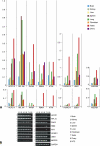Evolutionary history of novel genes on the tammar wallaby Y chromosome: Implications for sex chromosome evolution
- PMID: 22128133
- PMCID: PMC3290785
- DOI: 10.1101/gr.120790.111
Evolutionary history of novel genes on the tammar wallaby Y chromosome: Implications for sex chromosome evolution
Abstract
We report here the isolation and sequencing of 10 Y-specific tammar wallaby (Macropus eugenii) BAC clones, revealing five hitherto undescribed tammar wallaby Y genes (in addition to the five genes already described) and several pseudogenes. Some genes on the wallaby Y display testis-specific expression, but most have low widespread expression. All have partners on the tammar X, along with homologs on the human X. Nonsynonymous and synonymous substitution ratios for nine of the tammar XY gene pairs indicate that they are each under purifying selection. All 10 were also identified as being on the Y in Tasmanian devil (Sarcophilus harrisii; a distantly related Australian marsupial); however, seven have been lost from the human Y. Maximum likelihood phylogenetic analyses of the wallaby YX genes, with respective homologs from other vertebrate representatives, revealed that three marsupial Y genes (HCFC1X/Y, MECP2X/Y, and HUWE1X/Y) were members of the ancestral therian pseudoautosomal region (PAR) at the time of the marsupial/eutherian split; three XY pairs (SOX3/SRY, RBMX/Y, and ATRX/Y) were isolated from each other before the marsupial/eutherian split, and the remaining three (RPL10X/Y, PHF6X/Y, and UBA1/UBE1Y) have a more complex evolutionary history. Thus, the small marsupial Y chromosome is surprisingly rich in ancient genes that are retained in at least Australian marsupials and evolved from testis-brain expressed genes on the X.
Figures




Similar articles
-
Marsupial genome sequences: providing insight into evolution and disease.Scientifica (Cairo). 2012;2012:543176. doi: 10.6064/2012/543176. Epub 2012 Nov 25. Scientifica (Cairo). 2012. PMID: 24278712 Free PMC article. Review.
-
Chromosome Evolution in Marsupials.Genes (Basel). 2018 Feb 6;9(2):72. doi: 10.3390/genes9020072. Genes (Basel). 2018. PMID: 29415454 Free PMC article. Review.
-
The tammar wallaby major histocompatibility complex shows evidence of past genomic instability.BMC Genomics. 2011 Aug 19;12:421. doi: 10.1186/1471-2164-12-421. BMC Genomics. 2011. PMID: 21854592 Free PMC article.
-
Shared DNA sequences between the X and Y chromosomes in the tammar wallaby - evidence for independent additions to eutherian and marsupial sex chromosomes.Chromosoma. 1997 Jul;106(2):94-8. doi: 10.1007/s004120050228. Chromosoma. 1997. PMID: 9215558
-
The marsupial MHC: the tammar wallaby, Macropus eugenii, contains an expressed DNA-like gene on chromosome 1.J Mol Evol. 1994 May;38(5):496-505. doi: 10.1007/BF00178850. J Mol Evol. 1994. PMID: 8028029
Cited by
-
No evidence for a second evolutionary stratum during the early evolution of mammalian sex chromosomes.PLoS One. 2012;7(10):e45488. doi: 10.1371/journal.pone.0045488. Epub 2012 Oct 19. PLoS One. 2012. PMID: 23094017 Free PMC article.
-
Chromosome-wide profiling of X-chromosome inactivation and epigenetic states in fetal brain and placenta of the opossum, Monodelphis domestica.Genome Res. 2014 Jan;24(1):70-83. doi: 10.1101/gr.161919.113. Epub 2013 Sep 24. Genome Res. 2014. PMID: 24065774 Free PMC article.
-
Marsupial genome sequences: providing insight into evolution and disease.Scientifica (Cairo). 2012;2012:543176. doi: 10.6064/2012/543176. Epub 2012 Nov 25. Scientifica (Cairo). 2012. PMID: 24278712 Free PMC article. Review.
-
Chromosome Evolution in Marsupials.Genes (Basel). 2018 Feb 6;9(2):72. doi: 10.3390/genes9020072. Genes (Basel). 2018. PMID: 29415454 Free PMC article. Review.
-
Evolution of Dosage Compensation in Anolis carolinensis, a Reptile with XX/XY Chromosomal Sex Determination.Genome Biol Evol. 2017 Jan 1;9(1):231-240. doi: 10.1093/gbe/evw263. Genome Biol Evol. 2017. PMID: 28206607 Free PMC article.
References
-
- Asakawa S, Abe I, Kudoh Y, Kishi N, Wang Y, Kubota R, Kudoh J, Kawasaki K, Minoshima S, Shimizu N 1997. Human BAC library: construction and rapid screening. Gene 191: 69–79 - PubMed
-
- Bininda-Emonds OR, Cardillo M, Jones KE, MacPhee RD, Beck RM, Grenyer R, Price SA, Vos RA, Gittleman JL, Purvis A 2007. The delayed rise of present-day mammals. Nature 446: 507–512 - PubMed
-
- Carvalho-Silva DR, O'Neill RJ, Brown JD, Huynh K, Waters PD, Pask AJ, Delbridge ML, Graves JAM 2004. Molecular characterization and evolution of X and Y-borne ATRX homologues in American marsupials. Chromosome Res 12: 795–804 - PubMed
-
- Charlesworth B 1991. The evolution of sex chromosomes. Science 251: 1030–1033 - PubMed
-
- Deakin JE, Koina E, Waters PD, Doherty R, Patel VS, Delbridge ML, Dobson B, Fong J, Hu Y, van den Hurk C, et al. 2008. Physical map of two tammar wallaby chromosomes: a strategy for mapping in non-model mammals. Chromosome Res 16: 1159–1175 - PubMed
Publication types
MeSH terms
LinkOut - more resources
Full Text Sources
Research Materials
Miscellaneous
